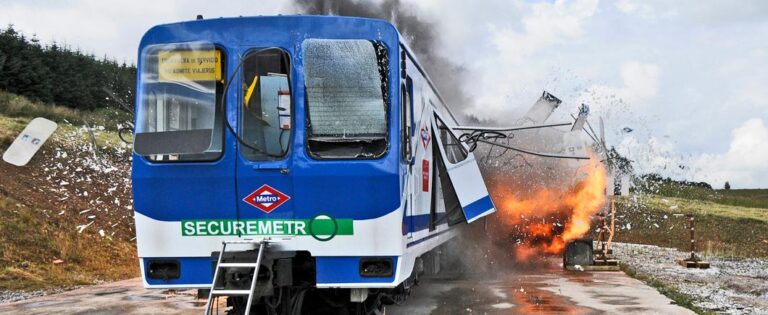Over two hundred train and metro passengers lost their lives in the terrorist attacks that hit Madrid and London in 2004 and 2005. Governments and transport services across the EU have remained on red alert since.To make urban transport safer, researchers at the EUR 40 million SECUR-ED project are developing smart facial recognition technology that can automatically follow suspicious people from camera to camera.“‘We are teaching the algorithm to recognise abandoned luggage and follow the person who left it.’Philippe Moutou, leader of the research team at Thales‘Our surveillance software identifies the facial features of people filmed by CCTV cameras,’ explained Philippe Moutou, who runs a research team at Thales that develops tracking algorithms as part of the SECUR-ED project.The software can follow people as they move through the transport system because of its ability to identify people from one camera to the next. This has already proved its value in combating vandalism and pickpocketing, assisting police officers who encounter difficulties in reaching crime scenes in time.‘In a similar way, we are teaching the algorithm to recognise abandoned luggage and follow the person who left it,’ said Moutou.At the moment, there are limits to what can be done with CCTV surveillance. The facial recognition software is only good enough to give operators a selection of possible matches, meaning that with 800 000 people transiting a single Paris metro station each day, transport operators lack the manpower to follow suspects for long.Pending revolutionHowever, Moutou is already looking towards the next step, which will be to build that human capacity for facial recognition and intuition into automatic systems, meaning the systems will be able to track suspects for much longer.‘The brain is infinitely superior at identifying people and understanding situations than any machine around today. It breaks down images and reassembles them at an amazing rate, but we don’t know how. That is the pending revolution in our field. If we really want our algorithms to work independently, we need a leap in our understanding of how the visual cortex works.’Automatic video tracking of people is an intrusion, but one that could save lives in the event of a terrorist attack. When deciding whether to finance projects that deal with security and surveillance, the EU looks at the impact it would have on society.‘Our projects, before they are financed, are always subject to an ethical review,’ said a poject and policy officer fromthe EU’s Directorate-General for Enterprise and Industry who deals with security research.‘We want to make sure research is compliant with existing data-protection legislation, that it is privacy-friendly, and that it will not have any negative impact on society.’High-tech surveillance can help prevent an attack, but if an attack were to happen, then smart railway carriage design could still help to reduce casualties, and the EU-funded project SecureMetro is working out how to make metro carriages more resilient to explosion.Simulation expert Umberto Battista at Stam in Italy, one of the project’s partners, used software to map out what happens in the split second of an explosion inside a carriage.‘The result is a very heavy simulation,’ Battista said. ‘Ten years ago, it might have been unsolvable. But thanks to advances in processing power, our computers can now run it in a week.’Project partner Tecnalia, in Spain, then studied the response of different materials to explosions and debris. ‘We layered energy-absorbing materials with fragment-resistant materials, and strengthened windows with stacks of micron-thick films,’ said Richard Seddon, who led the research team. ‘Components were tested by raining projectiles on it through an air cannon and blasting it with live explosives,’ and these results were incorporated into the model used by the simulation.Finally, a blast-resilient carriage was built by SecureMetro’s manufacturing partner, Sunsundegi, which hasa much lower level of debris projection, making it safer in case of a blast.These technologies could help make public transport safer in the future, however at the moment stricter security rules and greater public awareness are still the main assets in reducing the risk of terrorist attacks, according to Jean-Luc Planchet, who runs security projects at RATP, the company that operates the Paris public transport network.’There is no single piece of technology that can solve the threat of a terrorist attack,’ he said. ‘But these projects have shed light on technologies that can help us better protect our passengers in the future.’
This article was originally published in Horizon, the EU Research and Innovation magazine.
Add to favorites:
Share:
Listing Description
Video
Documents
No documents available.
Ask KETMarket to make a contact
Connect with the Listing Owner!
💬 Please log in now to askKETMarket to make a contact. Not a member yet? Sign up for free and start connecting today!
Video
Related Funding and Finance Opportunities
Unlock Exclusive Funding Opportunities!
🔑 Get instant access to tailored funding opportunities that perfectly match your needs. This powerful feature is exclusively available to our premium members—helping you save time, stay ahead of the competition, and secure the right funding faster.
Upgrade to Premium now and never miss an important opportunity again! Already a premium member? Log in here to explore your matches.
Related Innovation Offers
Discover Tailored Innovation Offers!
🚀 Gain access to technology solutions that match your specific needs and interests—carefully selected to support your innovation goals. These offers are exclusively available to our premium members, helping you identify relevant technologies faster and start the right conversations with potential partners.
Upgrade to Premium now and explore your personalized technology matches today! Already a premium member? Log in here to view your tailored offers.
Related Knowledgeable Resources
Discover More with Premium: Related Knowledge Resources
🔒 You’re missing out on expert-curated knowledge specifically matched to this topic. As a Premium member, you gain exclusive access to in-depth articles, guides, and insights that help you make smarter decisions, faster.
Whether you’re preparing a funding proposal, researching a new market, or just need reliable information—our Premium knowledge matches save you hours of research and point you directly to what matters.
Upgrade to Premium now and instantly unlock relevant knowledge tailored to your needs! Already a member? Log in here to view your personalized content.

